sensor SKODA OCTAVIA 2007 1.G / (1U) User Guide
[x] Cancel search | Manufacturer: SKODA, Model Year: 2007, Model line: OCTAVIA, Model: SKODA OCTAVIA 2007 1.G / (1U)Pages: 288, PDF Size: 15.19 MB
Page 122 of 288
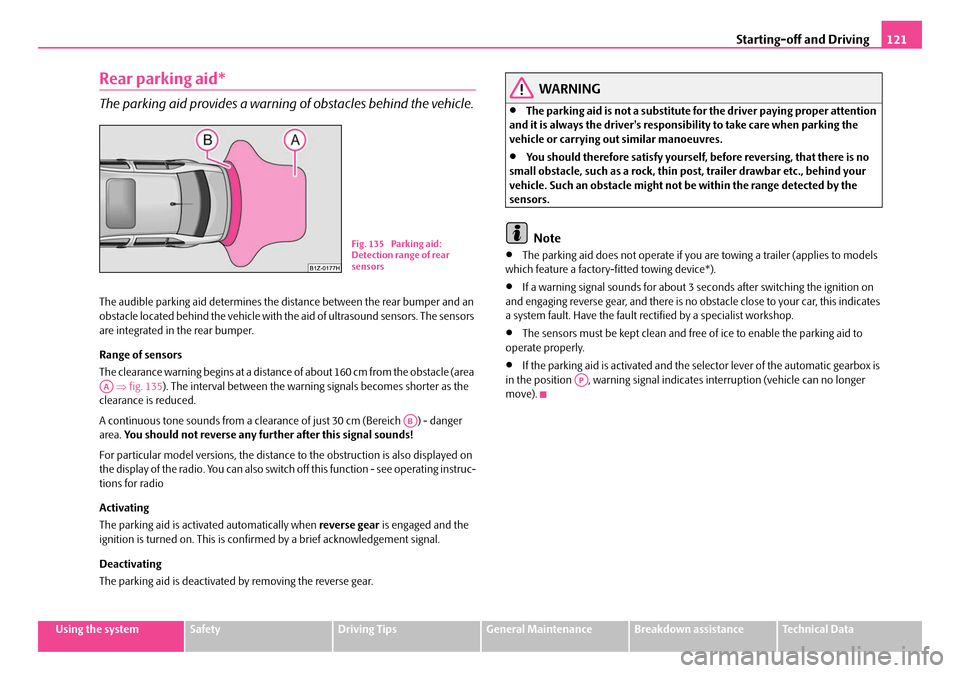
Starting-off and Driving121
Using the systemSafetyDriving TipsGeneral MaintenanceBreakdown assistanceTechnical Data
Rear parking aid*
The parking aid provides a warning of obstacles behind the vehicle.
The audible parking aid determines the distance between the rear bumper and an
obstacle located behind the vehicle with the aid of ultrasound sensors. The sensors
are integrated in the rear bumper.
Range of sensors
The clearance warning begins at a distance of about 160 cm from the obstacle (area
⇒ fig. 135 ). The interval between the warning signals becomes shorter as the
clearance is reduced.
A continuous tone sounds from a clearanc e of just 30 cm (Bereich ) - danger
area. You should not reverse any further after this signal sounds!
For particular model versions, the distance to the obstruction is also displayed on
the display of the radio. You can also switch off this function - see operating instruc-
tions for radio
Activating
The parking aid is activated automatically when reverse gear is engaged and the
ignition is turned on. This is confirmed by a brief acknowledgement signal.
Deactivating
The parking aid is deactivated by removing the reverse gear.
WARNING
•The parking aid is not a substitute for the driver paying proper attention
and it is always the driver's responsibility to take care when parking the
vehicle or carrying ou t similar manoeuvres.
•You should therefore satisfy yourself, before reversing, that there is no
small obstacle, such as a rock, thin po st, trailer drawbar etc., behind your
vehicle. Such an obstacle might not be within the range detected by the
sensors.
Note
•The parking aid does not operate if you are towing a trailer (applies to models
which feature a factory-fi tted towing device*).
•If a warning signal sounds for about 3 seconds after switching the ignition on
and engaging reverse gear, and there is no obstacle close to your car, this indicates
a system fault. Have the fault rectified by a specialist workshop.
•The sensors must be kept clean and free of ice to enable the parking aid to
operate properly.
•If the parking aid is activated and the selector lever of the automatic gearbox is
in the position , warning signal indicates interruption (vehicle can no longer
move).
Fig. 135 Parking aid:
Detection range of rear
sensors
AA
AB
AP
NKO A5 20 MR08.book Page 121 Wednesday, April 11, 2007 2:54 PM
Page 123 of 288

Starting-off and Driving
122
Front and rear parking aid*
The parking aid provides a warning of obstacles in front and behind
the vehicle.
The audible parking aid determines the distance between the front or rear bumper
and an obstacle with the aid of ultrasound sensors. The sensors are integrated in the
front and rear bumper. The signal tones for the front parking aid sound higher than
for the rear parking aid.
Range of sensors
The distance warning begins at a distance of about 120 cm from the obstacle in
front of the vehicle (area ⇒fig. 137 ) and about 160 cm from the obstacle behind the vehicle (area
⇒page 121, fig. 135). The interval between the
warning signals becomes shorter as the clearance is reduced.
A continuous tone sounds from a clearanc e of just 30 cm (area ) - danger area.
You should not reverse any further after this signal sounds!
Your vehicle can be equipped with a radio which shows on its display the distance
of the vehicle to the obstacle. You can also switch off this function - see operating
instructions for radio
Activating
The parking aid is activated when the reverse gear is engaged and the ignition is
turned on or by pressing the button ⇒fig. 136 - the symbol
lights up in the
button. The activation is confirmed by a brief acknowledgement signal.
Deactivating
The parking aid is deactivated after pressing the button
⇒ fig. 136 or at a speed
of more than 15 km/h - the symbol in the button is no longer illuminated.
WARNING
•The parking aid is not a substitute fo r the driver paying proper attention
and it is always the driver's responsibility to take care when reversing the
vehicle or carrying out similar manoeuvres.
•You should therefore satisfy yourself, before reversing, that there is no
small obstacle, such as a rock, thin po st, trailer drawbar etc., in front or
behind your vehicle. Such an obstacle might not be within the range
detected by the sensors.
Caution
In order to ensure the correct functioning of the parking aid, only a licence plate
frame approved by the manufacturer Škod a for your vehicle type should be
installed at the front bumper. Non-proved licence plate frames can project into the
detection range ⇒fig. 137 . A non-proved licence plate frame could be recog-
nized as an obstacle by the system and this would lead to an incorrect warning. If
you have any questions, please contact a specialist garage.
Fig. 136 Activating the
parking aid
Fig. 137 Parking aid:
Detection range of the
front sensors
AA
AA
AB
AB
NKO A5 20 MR08.book Page 122 Wednesday, April 11, 2007 2:54 PM
Page 124 of 288
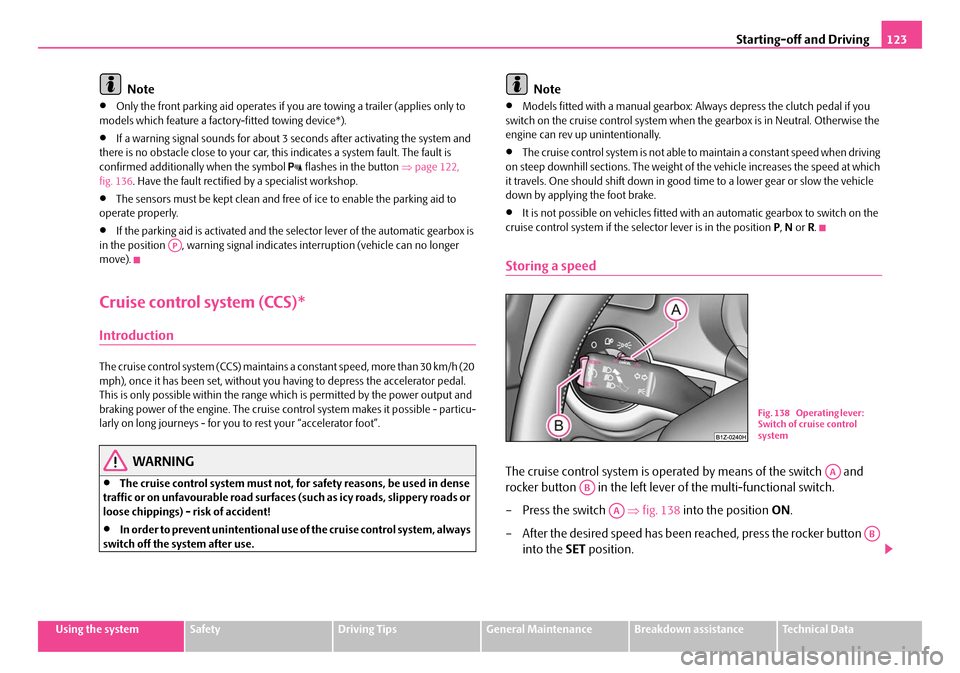
Starting-off and Driving123
Using the systemSafetyDriving TipsGeneral MaintenanceBreakdown assistanceTechnical Data
Note
•Only the front parking aid operates if you are towing a trailer (applies only to
models which feature a factory-fitted towing device*).
•If a warning signal sounds for about 3 seconds after activating the system and
there is no obstacle close to your car, th is indicates a system fault. The fault is
confirmed additionally when the symbol
flashes in the button ⇒page 122,
fig. 136 . Have the fault rectified by a specialist workshop.
•The sensors must be kept clean and free of ice to enable the parking aid to
operate properly.
•If the parking aid is activated and the se lector lever of the automatic gearbox is
in the position , warning signal indicates interruption (vehicle can no longer
move).
Cruise control system (CCS)*
Introduction
The cruise control system (CCS) maintains a constant speed, more than 30 km/h (20
mph), once it has been set, without you having to depress the accelerator pedal.
This is only possible within the range wh ich is permitted by the power output and
braking power of the engine. The cruise co ntrol system makes it possible - particu-
larly on long journeys - for you to rest your “accelerator foot”.
WARNING
•The cruise control system must not, for safety reasons, be used in dense
traffic or on unfavourable road surfaces (such as icy roads, slippery roads or
loose chippings) - risk of accident!
•In order to prevent unintentional use of the cruise control system, always
switch off the system after use.
Note
•Models fitted with a manual gearbox: Al ways depress the clutch pedal if you
switch on the cruise control system when the gearbox is in Neutral. Otherwise the
engine can rev up unintentionally.
•The cruise control system is not able to maintain a constant speed when driving
on steep downhill sections. The weight of the vehicle increases the speed at which
it travels. One should shift down in good time to a lower gear or slow the vehicle
down by applying the foot brake.
•It is not possible on vehicles fitted with an automatic gearbox to switch on the
cruise control system if the sele ctor lever is in the position P, N or R.
Storing a speed
The cruise control system is operated by means of the switch and
rocker button in the left lever of the multi-functional switch.
– Press the switch ⇒fig. 138 into the position ON.
– After the desired speed has been reached, press the rocker button into the SET position.
AP
Fig. 138 Operating lever:
Switch of cruise control
system
AA
AB
AA
AB
NKO A5 20 MR08.book Page 123 Wednesday, April 11, 2007 2:54 PM
Page 169 of 288

Airbag system
168
Function of the side airbags
Risk of injury to the upper part of the body is reduced by fully inflated
side airbags.
In the case of a violent side crash the side airbag on the front seat on the side on
which the collision occurs is deployed ⇒fig. 169 .
In certain accident situations both the fr ont airbags as well as the head and side
airbags may be deployed together.
If an airbag is deployed, the airbag is fill ed with propellant gas. The airbags inflate
in fractions of a second and at a high spee d in order to be able to offer that addi-
tional protection in the event of an accident.
A grey white, non harmful gas is released when airbag is inflated. This is perfectly
normal and is not an indication of a fire in the vehicle.
The load of the occupants is cushioned when plunging into the fully inflated airbag
and the risk of injury to the entire u pper body (chest, stomach and pelvis) is
reduced on the side facing the door.
Important safety information on the side airbag
Correct use of the airbag system considerably reduces the risk of
injury!
WARNING
•It is essential to always switch off ⇒page 171, “Deactivating an airbag”
the front passenger airbag when attach ing a child safety seat on the front
passenger seat where the child is seated with its back facing in direction of
travel (in some countries al so when the child is facing the direction of travel).
If this is not done, there is a risk of the child suffering severe or even fatal
injuries if the front passenger airbag is deployed. In certain countries
national legal provisions also requir e that the side or head passenger
airbags be deactivated. When transporting a child on the front passenger
seat, please comply with the appropri ate national regulations regarding the
use of child safety seats.
•Your head should never be positioned in the deployment area of the side
airbag. You might suffer severe injuries in the event of an accident. This
applies in particular to children who are transported without using a suit-
able child safety seat ⇒page 175, “Child safety and side airbag*”.
•If children adopt an incorrect seated position when travelling, they may
be exposed to an increased risk of injury in the event of an accident. This can
result in serious injuries ⇒page 173, “What you should know about trans-
porting children!”.
•There must not be any further persons, animals as well as objects posi-
tioned between the occupants and the deployment area of the airbag. There
must also be no accessories such as cup holders, attached to the doors to
enable the side airbags to activate properly.
•The airbag control unit operates together with the pressure sensors,
which are attached in the front doors. For this reason no adjustments must
be carried out at the doors as well as at the door panels (for example addi-
tional installation of loudspeakers). Resulting damages can have a negative
affect on the operation of the airbag system. All work on the front doors and
their panels must only be carried out by a specialist garage.
Fig. 169 Inflated side
airbag
NKO A5 20 MR08.book Page 168 Wednesday, April 11, 2007 2:54 PM
Page 170 of 288

Airbag system169
Using the systemSafetyDriving TipsGeneral MaintenanceBreakdown assistanceTechnical Data
•In the event of a side collision, the side airbags will not function properly,
if the sensors cannot measure the increasing air pressure inside the doors,
because the air can escape through lar ge, non-sealed openings in the door
panel.
−Never drive with removed inner door panels.
− Never drive, if parts of the inner door panel have been removed and
the remaining openings have not been properly sealed.
− Never drive, if the loud speakers in the doors have been removed, only
if the loudspeaker openings have been properly sealed.
− Always make sure that the openings are covered or filled, if additional
loudspeakers or other equipment parts are installed in the inner door
panels.
− Always work with a Škoda dealer or have it carried out by a competent
specialist workshop.
•Only hang light items of clothing on the clothes hooks to the vehicle.
Never leave any heavy or sharp-edged objects in the pockets of the items of
clothing.
•Ensure that there are no excessive forces, such as violent knocks, kicks
etc., impact on the backrests of the seats otherwise the system may be
damaged. The side airbags would not be deployed in such a case!
•Any seat or protective covers which you fit to the driver or front
passenger seats must only be of the type expressly authorized by Škoda
Auto. In view of the fact that the airbag inflates out of the backrest of the
seat, use of non-approved seat or protective covers would considerably
impair the protective function of the side airbag.
•Any damage to the original seat covers in the area of the side airbag
module must be repaired without delay by your specialist garage.
•The airbag modules in the front seats must not display any damage,
cracks or deep scratches. It is not permissible to use force in order to open
the modules.
•Any work on the side airbag system including removing and installing
system components because of other repa ir work (e.g. removing seats) must
only be carried out by a specialist garage.
Head airbags*
Description of the head airbags
The head airbag together with the side airbag offers enhanced occu-
pant protection in the ev ent of a side collision.
The head airbags are positioned above the doors on both sides in the interior of the
car ⇒fig. 170 . The installation positions are each marked with the “AIRBAG” logo.
The head airbag together with the three-po int seat belts and the side airbags, offers
additional protection for the head and neck area of the occupants in the event of a
side collision of major severity ⇒ in “Important safety information on the head
airbag” on page 170.
Apart from their normal protective function, a further task of the seat belts is to
also hold the driver and the occupants in a correct seated position in the event of a
side collision so as to enable the head airbags to offer the maximum protection.
WARNING (continued)WARNING (continued)
Fig. 170 Installation
position of the head
airbags
NKO A5 20 MR08.book Page 169 Wednesday, April 11, 2007 2:54 PM
Page 171 of 288
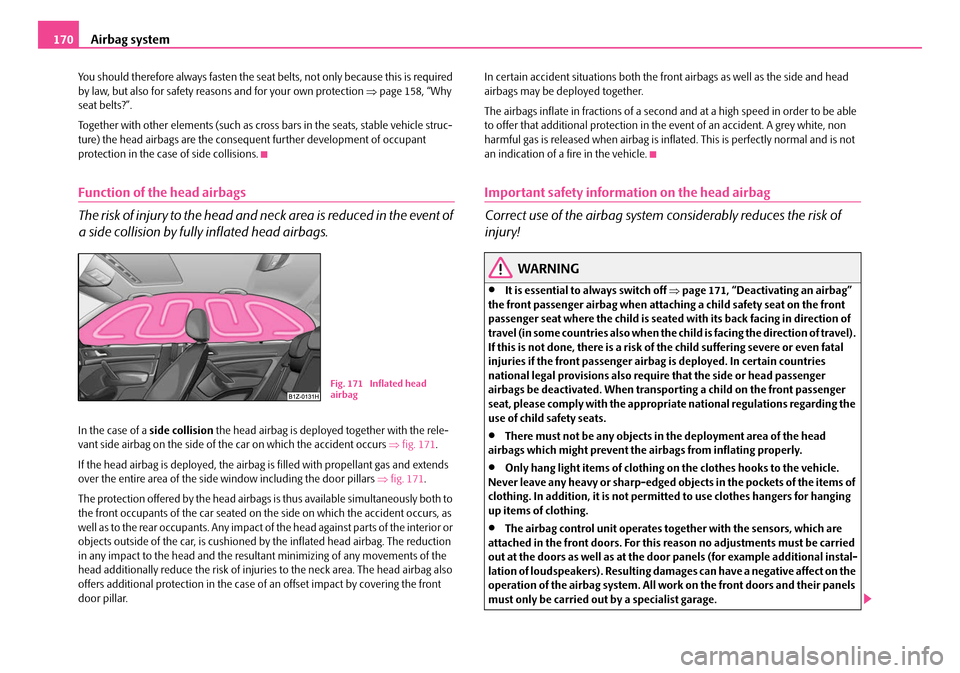
Airbag system
170
You should therefore always fasten the seat belts, not only because this is required
by law, but also for safety reasons and for your own protection ⇒page 158, “Why
seat belts?”.
Together with other elements (such as cros s bars in the seats, stable vehicle struc-
ture) the head airbags are the conseque nt further development of occupant
protection in the case of side collisions.
Function of the head airbags
The risk of injury to the head and neck area is reduced in the event of
a side collision by fully inflated head airbags.
In the case of a side collision the head airbag is deployed together with the rele-
vant side airbag on the side of th e car on which the accident occurs ⇒fig. 171 .
If the head airbag is deployed, the airbag is filled with propellant gas and extends
over the entire area of the side window including the door pillars ⇒fig. 171 .
The protection offered by the head airbags is thus available simultaneously both to
the front occupants of the car seated on th e side on which the accident occurs, as
well as to the rear occupants. Any impact of the head against parts of the interior or
objects outside of the car, is cushioned by the inflated head airbag. The reduction
in any impact to the head and the result ant minimizing of any movements of the
head additionally reduce the risk of injuries to the neck area. The head airbag also
offers additional protection in the case of an offset impact by covering the front
door pillar. In certain accident situations
both the front airbags as well as the side and head
airbags may be deployed together.
The airbags inflate in fractions of a second and at a high speed in order to be able
to offer that additional protection in the event of an accident. A grey white, non
harmful gas is released when airbag is infl ated. This is perfectly normal and is not
an indication of a fire in the vehicle.
Important safety information on the head airbag
Correct use of the airbag system considerably reduces the risk of
injury!
WARNING
•It is essential to always switch off ⇒page 171, “Deactivating an airbag”
the front passenger airbag when attach ing a child safety seat on the front
passenger seat where the child is seated with its back facing in direction of
travel (in some countries al so when the child is facing the direction of travel).
If this is not done, there is a risk of the child suffering severe or even fatal
injuries if the front passenger airbag is deployed. In certain countries
national legal provisions also requir e that the side or head passenger
airbags be deactivated. When transporting a child on the front passenger
seat, please comply with the appropri ate national regulations regarding the
use of child safety seats.
•There must not be any objects in the deployment area of the head
airbags which might prevent the airbags from inflating properly.
•Only hang light items of clothing on the clothes hooks to the vehicle.
Never leave any heavy or sh arp-edged objects in the pockets of the items of
clothing. In addition, it is not permit ted to use clothes hangers for hanging
up items of clothing.
•The airbag control unit operates together with the sensors, which are
attached in the front doors. For this reason no adjustments must be carried
out at the doors as well as at the door panels (for example additional instal-
lation of loudspeakers). Resulting dama ges can have a negative affect on the
operation of the airbag system. All work on the front doors and their panels
must only be carried out by a specialist garage.
Fig. 171 Inflated head
airbag
NKO A5 20 MR08.book Page 170 Wednesday, April 11, 2007 2:54 PM
Page 182 of 288
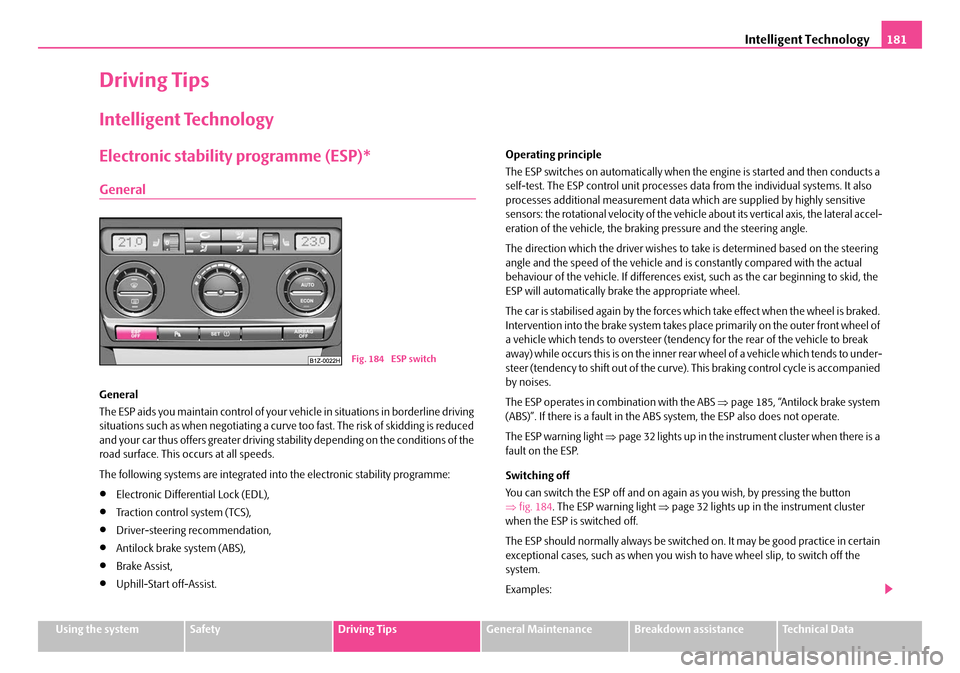
Intelligent Technology181
Using the systemSafetyDriving TipsGeneral MaintenanceBreakdown assistanceTechnical Data
Driving Tips
Intelligent Technology
Electronic stability programme (ESP)*
General
General
The ESP aids you maintain control of your vehicle in situations in borderline driving
situations such as when negotiating a curve too fast. The risk of skidding is reduced
and your car thus offers greater driving stability depending on the conditions of the
road surface. This occurs at all speeds.
The following systems are integrated into the electronic stability programme:
•Electronic Differential Lock (EDL),
•Traction control system (TCS),
•Driver-steering recommendation,
•Antilock brake system (ABS),
•Brake Assist,
•Uphill-Start off-Assist. Operating principle
The ESP switches on automatically when the engine is started and then conducts a
self-test. The ESP control unit processes data from the individual systems. It also
processes additional measurement data which are supplied by highly sensitive
sensors: the rotational velocity of the vehi
cle about its vertical axis, the lateral accel-
eration of the vehicle, the brakin g pressure and the steering angle.
The direction which the driver wishes to ta ke is determined based on the steering
angle and the speed of the vehicle and is constantly compared with the actual
behaviour of the vehicle. If differences exis t, such as the car beginning to skid, the
ESP will automatically brake the appropriate wheel.
The car is stabilised again by the forces which take effect when the wheel is braked.
Intervention into the brake system takes place primarily on the outer front wheel of
a vehicle which tends to oversteer (tendency for the rear of the vehicle to break
away) while occurs this is on the inner re ar wheel of a vehicle which tends to under-
steer (tendency to shift out of the curve). This braking control cycle is accompanied
by noises.
The ESP operates in combination with the ABS ⇒page 185, “Antilock brake system
(ABS)”. If there is a fault in the ABS system, the ESP also does not operate.
The ESP warning light ⇒page 32 lights up in the instrument cluster when there is a
fault on the ESP.
Switching off
You can switch the ESP off and on again as you wish, by pressing the button
⇒ fig. 184 . The ESP warning light ⇒page 32 lights up in the instrument cluster
when the ESP is switched off.
The ESP should normally always be switched on. It may be good practice in certain
exceptional cases, such as when you wish to have wheel slip, to switch off the
system.
Examples:
Fig. 184 ESP switch
NKO A5 20 MR08.book Page 181 Wednesday, April 11, 2007 2:54 PM
Page 183 of 288
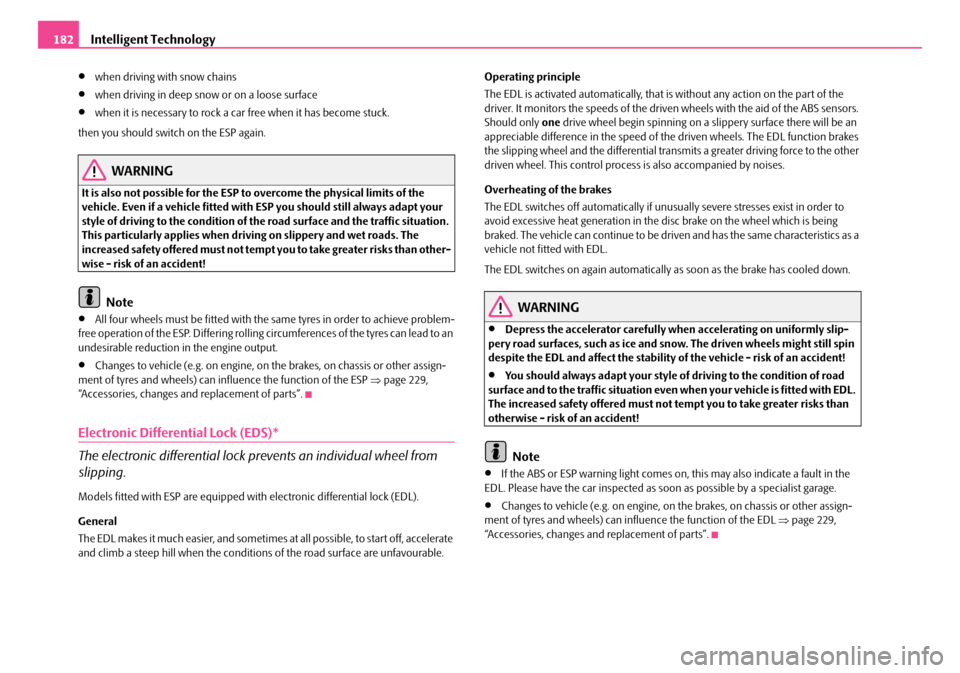
Intelligent Technology
182
•when driving with snow chains
•when driving in deep snow or on a loose surface
•when it is necessary to rock a ca r free when it has become stuck.
then you should switch on the ESP again.
WARNING
It is also not possible for the ESP to overcome the physical limits of the
vehicle. Even if a vehicle fitted with ESP you should still always adapt your
style of driving to the condition of the road surface and the traffic situation.
This particularly applies when driving on slippery and wet roads. The
increased safety offered must not tempt you to take greater risks than other-
wise - risk of an accident!
Note
•All four wheels must be fitted with the same tyres in order to achieve problem-
free operation of the ESP. Differing rolling circumferences of the tyres can lead to an
undesirable reduction in the engine output.
•Changes to vehicle (e.g. on engine, on the brakes, on chassis or other assign-
ment of tyres and wheels) can influence the function of the ESP ⇒page 229,
“Accessories, changes and replacement of parts”.
Electronic Differential Lock (EDS)*
The electronic differential lock pr events an individual wheel from
slipping.
Models fitted with ESP are equipped with electronic differential lock (EDL).
General
The EDL makes it much easier, and sometimes at all possible, to start off, accelerate
and climb a steep hill when the conditio ns of the road surface are unfavourable. Operating principle
The EDL is activated automatically, that is without any action on the part of the
driver. It monitors the speeds of the driven wheels with the aid of the ABS sensors.
Should only
one drive wheel begin spinning on a slippery surface there will be an
appreciable difference in the speed of the driven wheels. The EDL function brakes
the slipping wheel and the differential transmits a greater driving force to the other
driven wheel. This control proces s is also accompanied by noises.
Overheating of the brakes
The EDL switches off automatically if unusually severe stresses exist in order to
avoid excessive heat generation in the disc brake on the wheel which is being
braked. The vehicle can continue to be driven and has the same characteristics as a
vehicle not fitted with EDL.
The EDL switches on again automatically as soon as the brake has cooled down.
WARNING
•Depress the accelerator carefully when accelerating on uniformly slip-
pery road surfaces, such as ice and sn ow. The driven wheels might still spin
despite the EDL and affect the stability of the vehicle - risk of an accident!
•You should always adapt your style of driving to the condition of road
surface and to the traffic situation even when your vehicle is fitted with EDL.
The increased safety offered must not tempt you to take greater risks than
otherwise - risk of an accident!
Note
•If the ABS or ESP warning light comes on, this may also indicate a fault in the
EDL. Please have the car inspected as s oon as possible by a specialist garage.
•Changes to vehicle (e.g. on engine, on the brakes, on chassis or other assign-
ment of tyres and wheels) can in fluence the function of the EDL ⇒page 229,
“Accessories, changes and replacement of parts”.
NKO A5 20 MR08.book Page 182 Wednesday, April 11, 2007 2:54 PM
Page 184 of 288
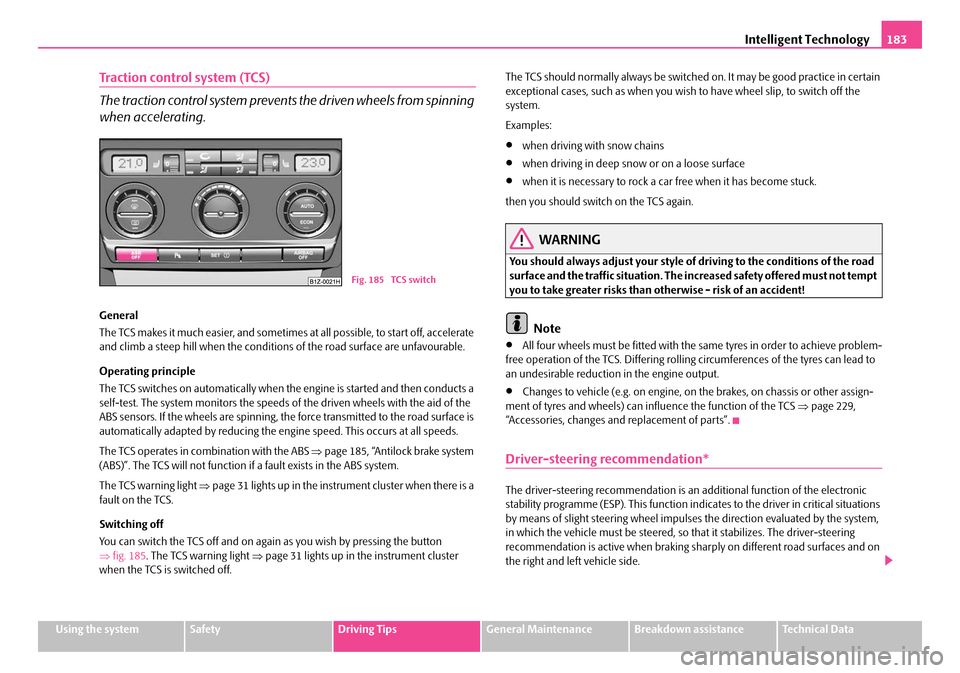
Intelligent Technology183
Using the systemSafetyDriving TipsGeneral MaintenanceBreakdown assistanceTechnical Data
Traction control system (TCS)
The traction control system prevents the driven wheels from spinning
when accelerating.
General
The TCS makes it much easier, and sometimes at all possible, to start off, accelerate
and climb a steep hill when the conditio ns of the road surface are unfavourable.
Operating principle
The TCS switches on automatically when th e engine is started and then conducts a
self-test. The system monitors the speeds of the driven wheels with the aid of the
ABS sensors. If the wheels are spinning, the force transmitted to the road surface is
automatically adapted by redu cing the engine speed. This occurs at all speeds.
The TCS operates in combination with the ABS ⇒page 185, “Antilock brake system
(ABS)”. The TCS will not function if a fault exists in the ABS system.
The TCS warning light ⇒page 31 lights up in the instrument cluster when there is a
fault on the TCS.
Switching off
You can switch the TCS off and on again as you wish by pressing the button
⇒ fig. 185 . The TCS warning light ⇒page 31 lights up in the instrument cluster
when the TCS is switched off. The TCS should normally always be switched on. It may be good practice in certain
exceptional cases, such as when you wish
to have wheel slip, to switch off the
system.
Examples:
•when driving with snow chains
•when driving in deep snow or on a loose surface
•when it is necessary to rock a car free when it has become stuck.
then you should switch on the TCS again.
WARNING
You should always adjust your style of driving to the conditions of the road
surface and the traffic situation. The increased safety offered must not tempt
you to take greater risks than otherwise - risk of an accident!
Note
•All four wheels must be fitted with the same tyres in order to achieve problem-
free operation of the TCS. Differing rolling circumferences of the tyres can lead to
an undesirable reduction in the engine output.
•Changes to vehicle (e.g. on engine, on the brakes, on chassis or other assign-
ment of tyres and wheels) can in fluence the function of the TCS ⇒page 229,
“Accessories, changes and replacement of parts”.
Driver-steering recommendation*
The driver-steering recommendation is an additional function of the electronic
stability programme (ESP). This function indicates to the driver in critical situations
by means of slight steering wheel impulses the direction evaluated by the system,
in which the vehicle must be steered, so that it stabilizes. The driver-steering
recommendation is active when braking shar ply on different road surfaces and on
the right and left vehicle side.
Fig. 185 TCS switch
NKO A5 20 MR08.book Page 183 Wednesday, April 11, 2007 2:54 PM
Page 188 of 288
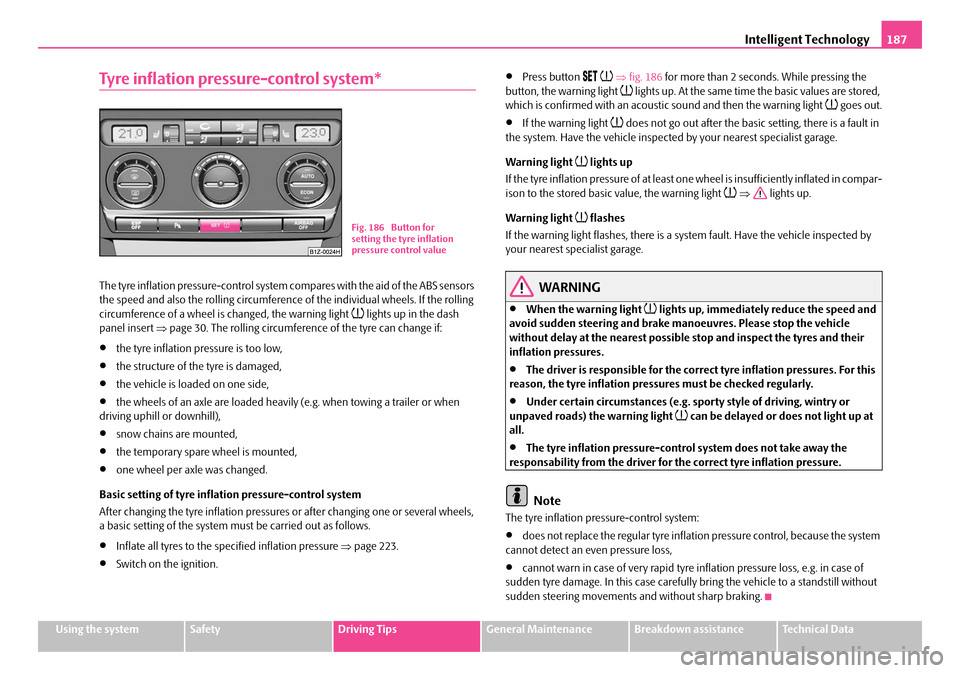
Intelligent Technology187
Using the systemSafetyDriving TipsGeneral MaintenanceBreakdown assistanceTechnical Data
Tyre inflation pressure-control system*
The tyre inflation pressure-control system compares with the aid of the ABS sensors
the speed and also the rolling circumference of the individual wheels. If the rolling
circumference of a wheel is changed, the warning light
lights up in the dash
panel insert ⇒page 30. The rolling circumference of the tyre can change if:
•the tyre inflation pressure is too low,
•the structure of the tyre is damaged,
•the vehicle is loaded on one side,
•the wheels of an axle are loaded heavily (e.g. when towing a trailer or when
driving uphill or downhill),
•snow chains are mounted,
•the temporary spare wheel is mounted,
•one wheel per axle was changed.
Basic setting of tyre inflation pressure-control system
After changing the tyre inflation pressures or after changing one or several wheels,
a basic setting of the system must be carried out as follows.
•Inflate all tyres to the specified inflation pressure ⇒page 223.
•Switch on the ignition.
•Press button ⇒ fig. 186 for more than 2 second s. While pressing the
button, the warning light lights up. At the same time the basic values are stored,
which is confirmed with an acoustic sound and then the warning light goes out.
•If the warning light does not go out after the basic setting, there is a fault in
the system. Have the vehicle inspected by your nearest specialist garage.
Warning light
lights up
If the tyre inflation pressure of at least on e wheel is insufficiently inflated in compar-
ison to the stored basic value, the warning light
⇒ lights up.
Warning light
flashes
If the warning light flashes, there is a system fault. Have the vehicle inspected by
your nearest specialist garage.
WARNING
•When the warning light lights up, immediately reduce the speed and
avoid sudden steering and brake mano euvres. Please stop the vehicle
without delay at the nearest possible stop and inspect the tyres and their
inflation pressures.
•The driver is responsible for the correc t tyre inflation pressures. For this
reason, the tyre inflation pressures must be checked regularly.
•Under certain circumstances (e.g. sporty style of driving, wintry or
unpaved roads) the warning light can be delayed or does not light up at
all.
•The tyre inflation pressure-control system does not take away the
responsability from the driver for the correct tyre inflation pressure.
Note
The tyre inflation pressure-control system:
•does not replace the regular tyre inflatio n pressure control, because the system
cannot detect an even pressure loss,
•cannot warn in case of very rapid tyre inflation pressure loss, e.g. in case of
sudden tyre damage. In this case carefully bring the vehicle to a standstill without
sudden steering movements and without sharp braking.
Fig. 186 Button for
setting the tyre inflation
pressure control value
NKO A5 20 MR08.book Page 187 Wednesday, April 11, 2007 2:54 PM